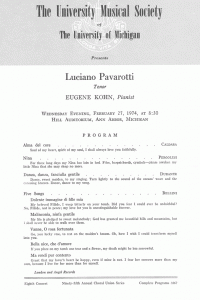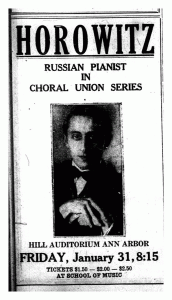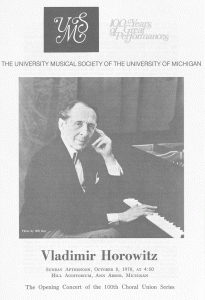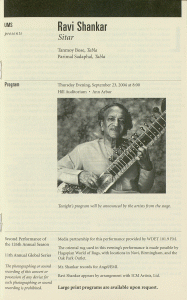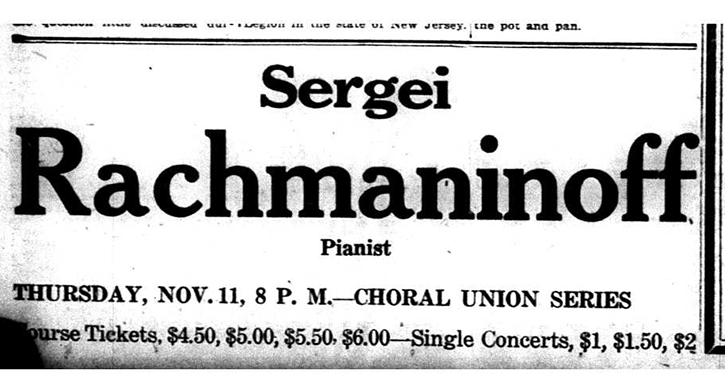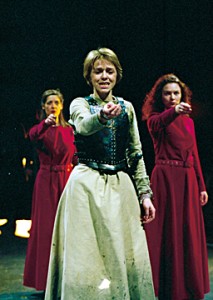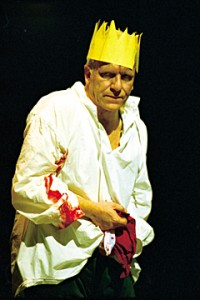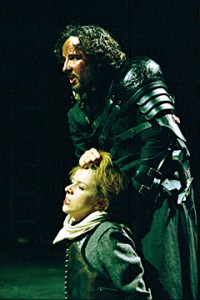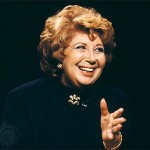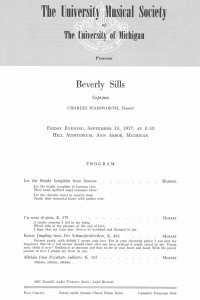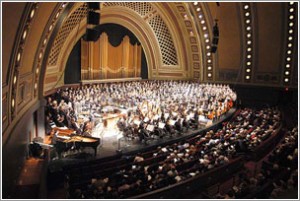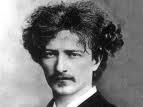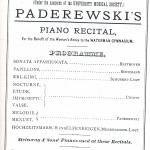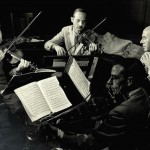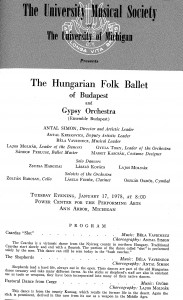This Day in UMS: Luciano Pavarotti
Editor’s Note: “This day in UMS History” is an occasional series of vignettes drawn from UMS’s historical archive. If you have a personal story or particular memory from attending the performance featured here, we’d love to hear from you in the comments.
February 27, 1974: Luciano Pavarotti
Photo: Program for the recital.
Luciano Pavarotti’s 1974 recital in Ann Arbor was only his second of his career. At lunch with Carol Wargelin, former UMS artistic administrator, he ordered two steak dinners and devoured both as she made notes on changes in his program for the evening.
Looking up from her notes, she caught him stealing ice cream from her dessert plate. Playing to his undeniable charm, she exacted repayment by asking him to sing a favorite aria. He sang it to her, right there, sotto voice.
This Day in UMS: Vladimir Horowitz
Editor’s Note: “This day in UMS History” is an occasional series of vignettes drawn from UMS’s historical archive. If you have a personal story or particular memory from attending the performance featured here, we’d love to hear from you in the comments.
January 31, 1930: Vladimir Horowitz in Hill Auditorium
Photos: (Left) 1930 advertisement in the Ann Arbor News (Ann Arbor News Ann Archives, Arbor District Library). (Right) Program from 1978 performance.
The great Russian pianist Vladimir Horowitz first performed in Ann Arbor on January 31, 1930, and then on another 8 occasions before 1953, when he began his long “intermission” from the concert stage. For music lovers, those years only enhanced his legend, and his return to stage in the 1970s caused a sensation.
For the inaugural concert of the hundredth season of UMS concerts in 1978, no artist could have been more fitting. Adding to the centennial pride of the local audience, the pianist was celebrating his fiftieth anniversary of his own American debut. This 1978 performance, before an enraptured audience, featured a program of works of Chopin, Rachmaninoff, and an enraptured audience found it hard to let Horowitz go, calling him back for four encores.
This Day in UMS: Ravi Shankar
Editor’s Note: “This day in UMS History” is an occasional series of vignettes drawn from UMS’s historical archive. If you have a personal story or particular memory from attending the performance featured here, we’d love to hear from you in the comments.
December 11: Anniversary of Ravi Shankar’s Death
Legendary virtuoso sitarist, composer, teacher, and writer, Ravi Shankar was India’s most esteemed musical Ambassador and a singular phenomenon in the classical music worlds of both East and West. A prolific composer, he composed numerous traditional ragas and talas, as well as many works involving western collaborations, including two concertos for sitar and orchestra for violinist Yehudi Mehunin and collaboration with Philip Glass, including the multi-artist work Orion, which opened the 2004 Cultural Olympiad in Greece. The New York Times called him the “Sitarist who introduced Indian Music to the West.”
UMS first had the honor of presenting Ravi Shankar in April 1996 in Rackham Auditorium. The program pictured above is from a solo performance in Hill Auditorium in September 2004.
This Day in UMS: Sergei Rachmaninoff
Editor’s Note: “This day in UMS History” is an occasional series of vignettes drawn from UMS’s historical archive. If you have a personal story or particular memory from attending the performance featured here, we’d love to hear from you in the comments.
November 11, 1920: Sergei Rachmaninoff in UMS Choral Union Series
Photo: Advertisement in the Ann Arbor News (Ann Arbor News Ann Archives, Arbor District Library).
The celebrated Russian pianist and composer Sergei Rachmaninoff performed solo in Hill Auditorium as part of the 42nd season of the Choral Union Series on November 11, 1920. He opened his recital with a performance of “The Star Spangled Banner,” during which the entire audience remained sanding. The remainder of his program consisted of six pieces: Beethoven’s Sonate Opus 90 in e minor, Mendelssohn’s Six Songs Without Words, Chopin’s Ballade, Valse, and Barcarolle, Grieg’s On the Mountains, Liszt’s Rhapsodie Espagnol, and his own Prelude, C-sharp minor Etude-Tableaux, Opus 33.
His masterful tone, unique personality, and flawless technique delighted a sold out Hill Auditorium, as audience members were in awe of his interpretation of his own works and how he portrayed the sorrow and fatalism of his own Russia. Sergei Rachmaninoff returned to Ann Arbor and Hill Auditorium for a second time in 1939, performing another solo recital as part of the 61st Choral Union Series.
This Day in UMS: Enrico Caruso
Editor’s Note: “This day in UMS History” is an occasional series of vignettes drawn from UMS’s historical archive. If you have a personal story or particular memory from attending the performance featured here, we’d love to hear from you in the comments.
October 19, 1918: Enrico Caruso with Nina Morgana, soprano, and Elias Breeskin, violinist
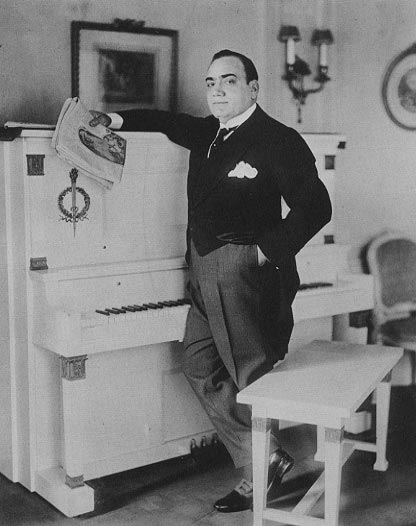
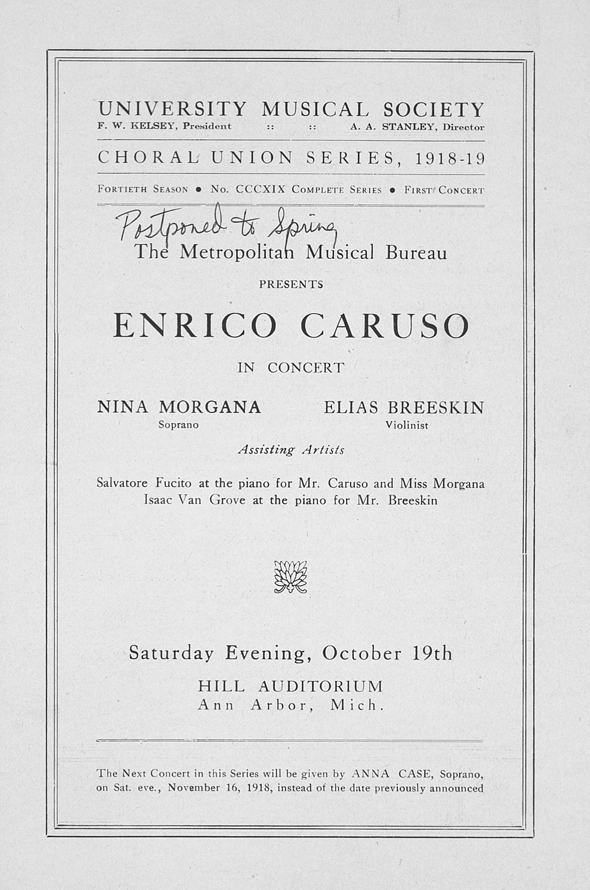
Photo: (Left) Enrico Caruso with his piano. (Right) UMS concert program.
Near the end of his 25-year career, Italian tenor Enrico Caruso was scheduled to sing selections from several operas during his performance alongside soprano Nina Morgana and violinist Elias Breeskin at Hill Auditorium in October of 1918. The performance was postponed until March of the following year due to the Spanish Flu pandemic.
The first singer to sell over a million copies of his recording, Caruso charmed audiences the world over as the first global media celebrity due to innovations in radio and television technology. His performance at UMS included an extensive repertoire of ten songs, all noted for their difficulty and beauty, including Souvenir de Moscow, Celste Aida, Una Furtiva Lagrima, Vesti La Giubba, and concluding with The Star Spangled Banner.
This Day in UMS History: Royal Shakespeare Company History Plays (March 10-18, 2001)
Ten years ago today, UMS audiences began a great experiment — the Royal Shakespeare Company presenting four Shakespeare History plays (Henry VI, parts i, ii, and iii, and Richard III) over the course of 27 hours with lunch and dinner breaks built in. The productions, directed by now-RSC artistic director Michael Boyd, marked the beginning of a long relationship between the University of Michigan and Ann Arbor with the RSC. Over the past decade, this partnership has included three major residencies, as well as workshopping new plays on the U-M campus. Each residency was accompanied by dozens of free educational events for students and the public-at-large.
Those who were present will no doubt fondly recall some of these images from the productions:
The three Henry VI plays were presented at 11 am, 2 pm, and 8 pm on a Saturday, with audiences returning on Sunday for the climactic production of Richard III. (There was also one mid-week cycle, which ran Tuesday, Wednesday [both matinee and evening], and Thursday.) Since that season, UMS’s theater programming has expanded significantly, with an annual commitment to presenting both live and high-definition broadcasts of international theater — including this season’s productions of Richard III and The Comedy of Errors by another British theater company, Propeller. Like the RSC, Propeller presents contemporary interpretations of Shakespeare and works with an ensemble cast; unlike the RSC, Propeller uses an all-male cast to present the Bard’s works, as would have been the case in Shakespeare’s day.
Richard III opens at the Power Center on Wednesday, March 30, and The Comedy of Errors opens the following evening. Tickets can be purchased at www.ums.org or by calling 734-764-2538.
In Memoriam: Joan Sutherland

Mrs. James Stewart, Pianist Richard Bonynge, Joan Sutherland, Helen Hayes and UMS President Gail Rector backstage at Hill Auditorium at her January 30, 1970 recital.
This week, we were sad to hear the news of soprano Joan Sutherland’s passing on Sunday.
Ms. Sutherland appeared at UMS three times throughout her career. She opened the 1964 May Festival as soloist with the Philadelphia Orchestra under the baton of Eugene Ormandy, performing arias from La Traviata and Lucia di Lammermoor, and returned twice for recital appearances in January 1970 and October 1979.
Were you at any of her UMS performances, or did you enjoy performances by her in other cities? Feel free to share your memories here.
This Day in UMS History: Laurie Anderson Meets the Great White Whale (Sept. 30-Oct. 2, 1999)
 Multi-media dominatrix Laurie Anderson opened the 1999/2000 UMS season with three performances of Songs and Stories from Moby Dick in the Power Center. The piece took Melville’s great novel as its inspiration, with Anderson’s signature penchant for the technological edge highlighted by the debut of the “Talking Stick,” a digital sampling machine that could replicate virtually any sound at a granular level. Anderson’s interest in developing the piece evolved because she was working on a project for high school kids about books with another producer (the project never materialized). She chose Moby Dick, remembering the novel’s obsessive captain, but also remembering, with dread, the incredible detail about the whaling industry and its technical paraphernalia. She was completely captivated by the novel as an adult, read it five times, and began to hear the music and lyricism in the author’s voice. From that experience, she began her largest undertaking in 15 years.
Multi-media dominatrix Laurie Anderson opened the 1999/2000 UMS season with three performances of Songs and Stories from Moby Dick in the Power Center. The piece took Melville’s great novel as its inspiration, with Anderson’s signature penchant for the technological edge highlighted by the debut of the “Talking Stick,” a digital sampling machine that could replicate virtually any sound at a granular level. Anderson’s interest in developing the piece evolved because she was working on a project for high school kids about books with another producer (the project never materialized). She chose Moby Dick, remembering the novel’s obsessive captain, but also remembering, with dread, the incredible detail about the whaling industry and its technical paraphernalia. She was completely captivated by the novel as an adult, read it five times, and began to hear the music and lyricism in the author’s voice. From that experience, she began her largest undertaking in 15 years.
This production was Laurie Anderson’s UMS debut (she has since appeared in 2002 with Happiness and in 2004 with The End of the Moon, and returns in January with Delusion). As a relative newcomer to the staff at that time, I traveled a few months before her Ann Arbor production to see the work in Philadelphia, at the Prince Theater. A night or two before I saw it, the actor playing Captain Ahab miscalculated the edge of the stage and fell into the orchestra pit, breaking his leg. I don’t recall the details of what happened that particular night — I think they canceled the performance — but by the time I arrived in Philadelphia, the actor was back on stage, manipulating his crutches through a surprisingly complicated stage choreography and making it seem as though that had been part of the design from the beginning. It turns out that although Captain Ahab is probably the most famous one-legged captain in literature, Anderson’s team had not considered using crutches until the accident forced the issue. By the time I saw the production in Ann Arbor several months later, the crutches had become an integral prop, perfectly incorporated into the storytelling.
Anderson’s ironic sense of humor permeated Moby Dick. In the program notes for the work, she noted, “Being a somewhat dark person myself, I love the idea that what you look for your whole life will eventually eat you alive.”
This performance brings back so many strong memories for me: how gracious Laurie Anderson was to break from tech rehearsals to give an interview to a public television TV show, how she willingly went to Detroit for a 20-minute interview on WDET, her generosity in allowing selected classes to see a dress rehearsal of the work in tech week. I also remember seeing an internet ticket order come in from somebody who lived in the same small town in Wisconsin where I grew up. This was in the early days of e-commerce, and it was shocking to see an address that was literally down the street from my childhood home, from someone renting an apartment in my late great-uncle’s house. Songs and Stories from Moby Dick was an incredible introduction to Laurie Anderson’s work and an amazing way to kick off the UMS season.
This Day in UMS History: Beverly Sills (September 23, 1977)
This Day in UMS History – September 23, 1977
Hill Auditorium
Beverly Sills, soprano
Charles Wadsworth, piano
Let the Bright Seraphim from Samson–Handel
Un moto di gioia, K. 579–Mozart
Bester Jüngling from Der Schauspieldirektor, K. 486–Mozart
Alleluia from Exsultate Jubilate, K. 165–Mozart
Many artists presented by UMS over its 132-year history have a long and rich history of performances with the organization. Soprano Beverly Sills was certainly no exception. Throughout the 1970s, Beverly Sills made numerous appearances under UMS auspices, culminating with this, her final appearance in 1977, just a few short years before announcing her retirement in 1980.
The late 60s and early to mid 70s were considered the high points of Beverly Sills’ career, as evidenced by her appearance on the cover of Time magazine in 1971, where she was described as “America’s Queen of Opera.” Beverly Sills’ first UMS appearance on January 30, 1971 was also a solo recital with Charles Wadsworth accompanying her on piano. On that particular program, Sills sang three arias from Handel’s opera seria Giulio Cesare. It is interesting to note that in 1966, Sills’ performance as Cleopatra in the New York City Opera’s revival of Handel’s then virtually unknown Giulio Cesare, is what many argue made her an international opera star.
Her final UMS program featured an aria from Handel’s oratorio Samson, considered by many to be one of Handel’s finest dramatic works, as well as three pieces by Mozart: concert aria “Un moto di gioia”, “Bester Jüngling” from the comic singspiel Der Schauspieldirektor (one of the only four vocal numbers in that piece), and “Alleluia” from the final allegro section of Mozart’s religious solo motet Exsultate Jubilate.
Following her retirement from performing, Beverly Sills remained quite active with the New York City Opera, serving on their board until 1991. Following that, she also served as chairman of Lincoln Center until 2002, and then as chairman of the Metropolitan Opera. Beverly Sills lost her battle with lung cancer on July 2, 2007 at the age of 78.
I hope you will take a moment to enjoy the video below and hear for yourself (if you weren’t able to attend any of her UMS performances!) the beauty and purity of tone of Beverly Sills’ voice as she sings one of my all-time favorite Mozart arias “Ruhe sanft, mein holdes Leben” from Zaide.
UMS Living Archive Interview: Joyce Holmes, Volunteer Usher
We continue our “UMS Living Archive” with a video interview with Joyce Holmes, volunteer usher. Joyce began ushering for UMS with her husband, Ken, in 1961, the same year they met and were married. Joyce shares the importance of UMS for her and Ken, who passed away this past spring. She also recalls a great memory from the May Festival of 1984 that literally blew open the doors of Hill Auditorium.
We dedicate this video to the memory of Ken Holmes, former UMS Tickets and Door Supervisor. Ken, you are greatly missed.
This Day in UMS History: Royal Philharmonic Orchestra (Feb 19, 1985)
Editor’s Note: Royal Philharmonic Orchestra performs in Ann Arbor on January 11, 2016.
February 19, 1985
Hill Auditorium, Ann Arbor
Royal Philharmonic Orchestra
Yehudi Menuhin, conductor
“While Yehudi Menuhin’s name is synonymous with the violin, he is also regarded as one of today’s finer conductors.” So begins the biographical note for the concert of this orchestra, which in 1986 counted André Previn as its Music Director and the Queen Mum as its patron. Menuhin’s name is indeed synonymous with the violin, but even for a violinist he had an unusual life. He was raised in California, studied in Europe with Georges Enesco, and as a teenager was an internationally famous violinist. During World War II, he flew, sometimes in dangerous conditions, to military hospitals to perform for wounded soldiers – acts for which France later honored him with the Legion of Honor (making him its youngest recipient). He was a close friend and collaborator with famous Indian sitarist Ravi Shankar (who, still going strong at 90 years old, recently appeared at Hill with his daughter Anoushka) and released joint recordings with legendary jazz violinist Stephane Grappelli. He founded the Yehudi Menuhin School in Surrey, England, received fourteen honorary doctorates, and was made a life peer by Queen Elizabeth II. He died in 1999.
“This day in UMS History” is an occasional series of vignettes drawn from UMS’s historical archive. If you have a personal story or particular memory from attending the performance featured here, we’d love to hear from you in the comments.
What Are YOUR Most Memorable UMS Performances?
This Day in UMS History: “Paderewski’s Piano Recital” (Feb 15, 1892)
February 15, 1892
University Hall, Ann Arbor
During my time at UMS, I’ve become used to seeing the ghosts of famous musicians. I’ve stumbled across signed photos of Jascha Heifetz (for whose violin classes current U-M Professor Martin Katz played) and records of Sergei Rachmaninov’s appearances at Hill. Even so, I did a double take when I found the program for Ignace Paderewski. The billing simply said “Paderewski’s Piano Recital”, adding that it was “For the Benefit of the Woman’s Annex to the WATERMAN GYMNASIUM.” I figured it was a society named after the Polish composer-pianist, and was very excited to discover that it was in fact a recital by Paderewski himself. I was even more excited to learn more about this pianist – I knew from Arthur Rubinstein’s memoirs that he was an inspirational pianist, mentor, and composer – but I also found out that he was an ardent Polish patriot, and was even Prime Minister of Poland for a brief time.
His recital program was formidable (Beethoven, Schumann, Chopin, Liszt transcriptions of works by Schubert and Mendelssohn, and his own compositions), as befits a pianist who had just conquered the musical capitals of Europe (UMS’ archives includes a biography of Paderewski by a London reviewer) and was in the process of doing the same to America’s musical capitals – then as now including Ann Arbor. Paderewski returned to Ann Arbor five more times, the last in 1933. He died while on tour in New York City in 1941. He was buried in Arlington National Cemetery until 1992, when his remains were brought to Warsaw.
“This day in UMS History” is an occasional series of vignettes drawn from UMS’s historical archive. If you have a personal story or particular memory from attending the performance featured here, we’d love to hear from you in the comments.
History – In the Making!
 Exciting news! After dreaming for years of digitizing the UMS archive, this massive project is finally underway! UMS has teamed up with the Ann Arbor District Library to digitize the UMS archive in all of its many forms: programs, photos, publications, and more. Please stay tuned as we continue to build and tweak a fully-searchable database for you to explore. Even more exciting are the innovative features we plan to include to create a “living” archive: the opportunity to submit your own comments, memories, and observations about events that you attended, whether that event was 50 years ago or yesterday! We’ll be asking for stories from patrons, donors, artists, ushers, staff, crew, and other UMS stakeholders to make this historical archive of the performing arts in Ann Arbor come alive.
Exciting news! After dreaming for years of digitizing the UMS archive, this massive project is finally underway! UMS has teamed up with the Ann Arbor District Library to digitize the UMS archive in all of its many forms: programs, photos, publications, and more. Please stay tuned as we continue to build and tweak a fully-searchable database for you to explore. Even more exciting are the innovative features we plan to include to create a “living” archive: the opportunity to submit your own comments, memories, and observations about events that you attended, whether that event was 50 years ago or yesterday! We’ll be asking for stories from patrons, donors, artists, ushers, staff, crew, and other UMS stakeholders to make this historical archive of the performing arts in Ann Arbor come alive.
In the meantime, please join UMS and the AADL for a sneak preview of the digitization progress in March!
A Sneak Peek into the Future of UMS’s Past:
100 Years of Concert Programs and Photographs
Sunday, March 14, 2010 at 2:00 pm
Ann Arbor District Library Downtown Branch, Multi-purpose Room
Join Ann Arbor District Library staff and Ken Fischer, President of UMS, as we launch two new online collections celebrating UMS’s concert history. We’ll show you how to browse and search thousands of pages of historical concert programs from UMS’s first 100 seasons; we’ll also unveil a growing collection of images that include both performance and rare backstage photographs of celebrated UMS artists over the past eight decades. Following a brief demonstration, Ken Fischer will present a talk on the history of the University Musical Society and the future of its archives.
This Day in UMS History: Mummenschanz (Jan 26 & 27, 1987)
January 26 & 27, 1987
Power Center
Mummenschanz
A Journey Into The Imagination
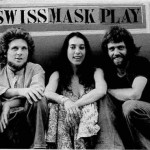 In 1972, Swiss actors Bernie Schürch and Andres Bossar and Italian-American actress Floriana Frassetto formed their now celebrated visual theatre group. They gave themselves an original name, Mummenschanz (roughly meaning masquerade), and set out with a sense of fun and imagination to invent a new form of theatre. Though each had a different background, the three artists were united by a common goal: to create a non-verbal theatrical language that would transcend the traditional barriers of nationality and culture. Since their first performance, these artists have thrilled audiences around the world with a spectacular and revolutionary nonverbal theatrical style, and have created figures and fantasy creatures in the shape of versatile face masks, half-body to whole-body masks and three-dimensional sculptural heads. I’m posting two vintage Mummenschanz videos. Above you’ll see a stage performance by Mummenschanz from 1983, and below a 1976 appearance on the Muppet Show.
In 1972, Swiss actors Bernie Schürch and Andres Bossar and Italian-American actress Floriana Frassetto formed their now celebrated visual theatre group. They gave themselves an original name, Mummenschanz (roughly meaning masquerade), and set out with a sense of fun and imagination to invent a new form of theatre. Though each had a different background, the three artists were united by a common goal: to create a non-verbal theatrical language that would transcend the traditional barriers of nationality and culture. Since their first performance, these artists have thrilled audiences around the world with a spectacular and revolutionary nonverbal theatrical style, and have created figures and fantasy creatures in the shape of versatile face masks, half-body to whole-body masks and three-dimensional sculptural heads. I’m posting two vintage Mummenschanz videos. Above you’ll see a stage performance by Mummenschanz from 1983, and below a 1976 appearance on the Muppet Show.
“This day in UMS History” is an occasional series of vignettes drawn from UMS’s historical archive. If you have a personal story or particular memory from attending the performance featured here, we’d love to hear from you in the comments.
This Day in UMS History: Hungarian Folk Ballet of Budapest (Jan 17, 1978)
January 17, 1978
Power Center
Hungarian Folk Ballet of Budapest and Gypsy Orchestra (Ensemble Budapest)
We hear a lot about Hungarian composers – Bartók and Liszt are common fare for music lovers, and even Haydn himself spent much of his life in the Hungarian country estate of Esterházy. But much less common is the chance not only to hear Hungarians perform their own music, but also to see Hungarian dancers perform traditional dances. The audience at the Power Center 21 years ago got to see a real Czardas, which the program says is “a virtuosic dance from northern Hungary.” Traditional Czardas start slowly and end with a flourish…This dance can still be seen today in the ‘bush ranches.’” I wish I’d been there to hear the Gypsy Orchestra play Franz Liszt’s Hungarian Fantasy, of which the program says, “Liszt adapted the most popular tunes of his age into this rhapsody, particularly the ‘verbunk’ or recruiting dance…The rhapsodic form of this fantasy gives us a thrilling and throbbing picture of Hungarian folk music as treated by one of the world’s greatest composers.” The video above is an example of the verbunk as danced by the Romafest Gypsy Dance Theater.
“This day in UMS History” is an occasional series of vignettes drawn from UMS’s historical archive. If you have a personal story or particular memory from attending the performance featured here, we’d love to hear from you in the comments.


